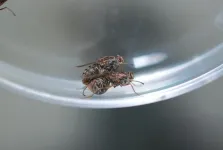(Press-News.org) We all know that the early bird gets the worm, but new research shows they turn to something far more nutritious for their breakfast.
Poo – either their own, or from other birds – provides them with essential nutrients, energy, and helps them adapt to new environments and seasonal variations, especially when they are developing.
New research led by the University of South Australia and published in Biological Reviews explains how eating faeces (known as coprophagy) shapes wild birds’ digestive tracts (gut biota), enabling them to absorb lost or deficient nutrients and adjust to seasonal variations in food sources.
This is especially important for long-migratory birds, which transition between fasting and fuelling metabolic states as they fly around the world.
Lead author Dr Barbara Drigo, a UniSA microbial ecologist, says consuming faeces modifies bacteria and microbes in the birds’ digestive tract, allowing them to adapt to new environments.
There is also some evidence that ingesting faeces could be a form of self-medication to fight infections in birds, although more research is needed to confirm this theory.
While coprophagy provides birds with essential nutrients, it also has a downside, Dr Drigo says, because birds can potentially harbour and transmit diseases to other birds and humans via their faeces.
“Depending on their geographical range, behaviour and interactions with other animals and environments, birds – especially migratory ones – can efficiently spread pathogens around the world.
“Eating bird faeces may also increase their exposure to antimicrobials, particularly pesticides and cleaning products, which lead to antimicrobial resistance,” Dr Drigo says.
And the reason why humans should never feed bread to birds is that it lowers diversity in their gut microbiota, whereas if birds source food from natural sites, their digestive tract is much healthier.
“Birds foraging in human environments are exposed to chemicals and metals from waste, sewage and refuse, which can alter their microbiota, potentially leading to antimicrobial resistance.”
Dr Drigo says a healthy avian gut is essential for regulating birds’ biological functions, and eating faeces plays a significant role in this. However, while coprophagy is inherently beneficial, it can expose birds to harmful antimicrobial substances.
“There’s an urgent need to thoroughly explore how various forms of coprophagy impact avian gut microbiomes, affecting bird health across their different life stages and environments,” she says.
Notes to editors
“Impacts of coprophagic foraging behaviour on the avian gut microbiome” is published in Biological Reviews and authored by researchers from the University of South Australia, University of Technology Sydney and University of Wollongong. DOI: 10.1111/brv.13036
For a full copy of the paper, email candy.gibson@unisa.edu.au
END
Who knew that eating poo was so vital for birds’ survival?
2024-03-13
ELSE PRESS RELEASES FROM THIS DATE:
Tsetse fly fertility damaged after just one heatwave, study finds
2024-03-13
The fertility of both female and male tsetse flies is affected by a single burst of hot weather, researchers at the University of Bristol and Stellenbosch University in South Africa have found.
The effects of a single heatwave were even felt in the offspring of heat exposed parents, with more daughters being born than sons.
The study, published today in Proceedings of the Royal Society B, helps explain why tsetse are declining in some parts of their range in Africa and has important implications for the disease they spread, particularly sleeping sickness in humans and nagana in cattle.
Lead author ...
New UAF lidar will add to space weather research capability
2024-03-12
University of Alaska Fairbanks scientists are developing a new light detection and ranging instrument to help gain a better understanding of space weather enveloping Earth.
The new laser radar, or lidar, will be the third for the UAF Geophysical Institute. It will measure temperature and neutrally charged iron in the upper atmosphere at altitudes of 75 to 125 miles, where the mesosphere and thermosphere meet.
Understanding the processes and influences at that altitude has become increasingly important as the proliferation of low-Earth orbit satellites continues and more nations send probes through ...
A simple and robust experimental process for protein engineering
2024-03-12
Image
A protein engineering method using simple, cost-effective experiments and machine learning models can predict which proteins will be effective for a given purpose, according to a new study by University of Michigan researchers.
The method has far-reaching potential to assemble proteins and peptides for applications from industry tools to therapeutics. For instance, this technique can help speed up the development of stabilized peptides for treating diseases in ways that current medicines can't, including improving how exclusively antibodies bind to their targets in immunotherapy.
"The rules that govern how proteins work, from sequence to structure to function, are ...
UTEP researchers to design movement-based training to support local health providers
2024-03-12
EL PASO, Texas (Mar. 12, 2024) – Burnout among health care workers is a well-documented problem that can exacerbate health disparities and limit access to care. Now, researchers at The University of Texas at El Paso are taking a creative approach in their search for a solution – a training program for providers that combines elements of art and science.
The project will examine the impact of a movement-based and somatics cross-training intervention on health care providers in the Paso del ...
Alaska dinosaur tracks reveal a lush, wet environment
2024-03-12
A large find of dinosaur tracks and fossilized plants and tree stumps in far northwestern Alaska provides new information about the climate and movement of animals near the time when they began traveling between the Asian and North American continents roughly 100 million years ago.
The findings by an international team of scientists led by paleontologist Anthony Fiorillo were published Jan. 30 in the journal Geosciences. Fiorillo researched in Alaska while at Southern Methodist University. He is now executive director of the New Mexico Museum of Natural History and Science.
University ...
Study: Best way to memorize stuff? It depends...
2024-03-12
Recent experiments by psychologists at Temple University and the University of Pittsburgh shed new light on how we learn and how we remember our real-world experiences.
The research, described in the March 12 online edition of Proceedings of the National Academy of Sciences (PNAS), suggests that varying what we study and spacing out our learning over time can both be helpful for memory — it just depends on what we’re trying to remember.
“Lots of prior research has shown that learning and ...
Exploring arctic plants and lichens: An important conservation baseline for Nunavut’s newest and largest territorial park
2024-03-12
Encompassing over 16 000 km2 of towering mountains, long fiords, lush valleys, and massive ice caps, Agguttinni Territorial Park is a protected area on northern Baffin Island, Nunavut, Canada. This park, and all of Nunavut, is Inuit Nunangat – Inuit homeland in Canada – and the park protects sites and biodiversity stewarded by Inuit since time immemorial.
Agguttinni means “where the prevailing wind occurs” in the Inuktitut local dialect. The park includes important bird areas, key habitats for polar bears and caribou, and numerous important Inuit cultural sites. It is very remote: no roads lead to it, and access ...
Multiple organ attack and immune dysregulation: Study reveals how the chikungunya virus leads to death
2024-03-12
The chikungunya virus, transmitted by Aedes aegypti and Aedes albopictus mosquitoes and responsible for more than 900 deaths in Brazil since it arrived around ten years ago, is capable of spreading through the blood, reaching multiple organs and crossing the blood-brain barrier, which protects the central nervous system. The mechanisms of action observed for the first time in fatal cases by a group of Brazilian, American and British researchers were reported in an article published on March 12 in the journal Cell Host & Microbe. The findings reinforce the need ...
Setting realistic expectations for recovery after robotic lung surgery
2024-03-12
Are surgeons giving patients unrealistic expectations about recovery after robotic lung surgery? That’s what CU Department of Surgery faculty member Robert Meguid, M.D., MPH, and surgery resident Adam Dyas, M.D., set out to discover after realizing the guidance they were offering patients might be based on outdated or anecdotal information.
“Traditionally, in surgery, we're taught to tell patients that they'll be back to normal from surgery within six weeks,” says Meguid, professor of cardiothoracic ...
UCF researchers lead $1.5 million project to improve efficiency of solar cells
2024-03-12
ORLANDO – A team of researchers from the University of Central Florida and the University of Delaware’s Institute of Energy Conversion has received a $1.5 million grant from the U.S. Department of Energy Solar Technologies Office to develop a novel metallization process that could improve the efficiency and lower the cost of solar cells, making solar energy more accessible to consumers.
The metallization process produces the metal contacts that are placed on the surface of silicon solar cells to ...


